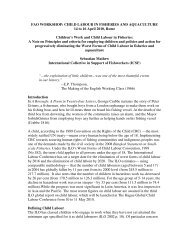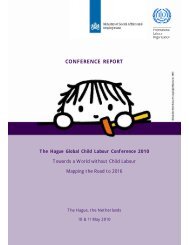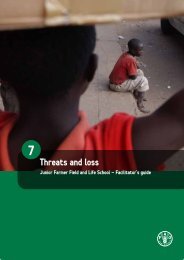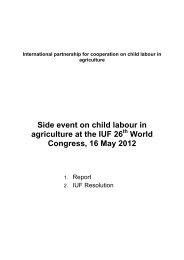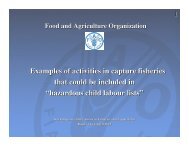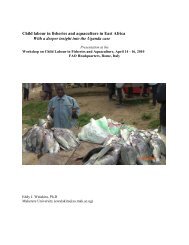Mainstreaming responses to the girl child in agriculture - Food ...
Mainstreaming responses to the girl child in agriculture - Food ...
Mainstreaming responses to the girl child in agriculture - Food ...
Create successful ePaper yourself
Turn your PDF publications into a flip-book with our unique Google optimized e-Paper software.
ma<strong>in</strong>stream <strong>child</strong> labour <strong>in</strong> <strong>the</strong>ir typical aid programmes generated a policy brief (June<br />
2008) for donors and this paper draws also on that work 5 .<br />
2. Effects of <strong>child</strong> labour <strong>in</strong> <strong>agriculture</strong> on <strong>girl</strong>s & boys<br />
Accord<strong>in</strong>g <strong>to</strong> <strong>the</strong> ILO (2006a) an estimated 70 per cent of <strong>the</strong> world’s ~218 million<br />
<strong>child</strong> labourers are agricultural workers. An estimated 132 million of all of <strong>the</strong> <strong>child</strong>ren<br />
who work <strong>in</strong> <strong>agriculture</strong> are <strong>girl</strong>s and boys aged between 5-14 years old. About 126<br />
million of <strong>the</strong>se 218 million boys and <strong>girl</strong>s are engaged <strong>in</strong> hazardous work, though <strong>the</strong><br />
precise figures <strong>in</strong> <strong>agriculture</strong> are not known (ILO, 2006a).<br />
It is difficult <strong>to</strong> obta<strong>in</strong> accurate figures on <strong>the</strong> <strong>to</strong>tal number of <strong>child</strong>ren engaged <strong>in</strong> <strong>child</strong><br />
labour <strong>in</strong> <strong>agriculture</strong>, let alone <strong>the</strong> gender breakdown between <strong>girl</strong>s and boys. Many<br />
work<strong>in</strong>g <strong>child</strong>ren may be perceived as help<strong>in</strong>g <strong>the</strong>ir parents or employers ra<strong>the</strong>r than<br />
labour<strong>in</strong>g and so <strong>the</strong>y are not counted <strong>in</strong> <strong>the</strong> <strong>to</strong>tal number of workers.<br />
2.1 Benefits from <strong>child</strong>ren help<strong>in</strong>g with <strong>agriculture</strong> work<br />
The <strong>agriculture</strong> and rural employment sec<strong>to</strong>r is not a homogenous basket with many<br />
differences relat<strong>in</strong>g <strong>to</strong> farm<strong>in</strong>g systems, farm sizes, farm <strong>in</strong>comes (on-farm versus offfarm),<br />
livelihood strategies, employment relationships, extent of modernisation,<br />
markets, household structure, land tenure, extent of migrant or seasonal workers and so<br />
on. Households <strong>in</strong>volved <strong>in</strong> farm<strong>in</strong>g (ei<strong>the</strong>r <strong>the</strong>ir own land or <strong>the</strong> land of o<strong>the</strong>rs) are<br />
likely <strong>to</strong> <strong>in</strong>volve both boys and <strong>girl</strong>s <strong>in</strong> <strong>the</strong> farm<strong>in</strong>g work <strong>the</strong>y are engaged <strong>in</strong>.<br />
Children’s participation <strong>in</strong> family farm activities helps <strong>the</strong>m learn valuable skills for<br />
future employment, build self-esteem and contribute <strong>to</strong> <strong>the</strong> generation of household<br />
<strong>in</strong>come, which has a positive impact on <strong>the</strong>ir own livelihoods. For many poorer<br />
families, <strong>the</strong> contribution of <strong>child</strong>ren is very important for family livelihoods and cop<strong>in</strong>g<br />
strategies. Age-appropriate tasks that do not <strong>in</strong>terfere with a <strong>child</strong>’s school<strong>in</strong>g and right<br />
<strong>to</strong> leisure time can be a normal part of grow<strong>in</strong>g up <strong>in</strong> a rural environment.<br />
The law <strong>in</strong> most countries <strong>in</strong>dicates that <strong>child</strong>ren must not work full time <strong>in</strong><br />
<strong>agriculture</strong> if <strong>the</strong>y are under <strong>the</strong> m<strong>in</strong>imum age for employment. However, young<br />
persons who have atta<strong>in</strong>ed <strong>the</strong> m<strong>in</strong>imum legal age for work (14-16 years of age<br />
depend<strong>in</strong>g on <strong>the</strong> country) should be encouraged <strong>to</strong> enter agricultural work as a means<br />
of promot<strong>in</strong>g youth employment. It is important <strong>to</strong> ensure that older <strong>child</strong>ren receive<br />
proper tra<strong>in</strong><strong>in</strong>g, have good levels of health and safety protection, and work under decent<br />
conditions. Under no circumstances should any <strong>child</strong>, under 18 years of age carry out<br />
“work which, by its nature or <strong>the</strong> circumstances <strong>in</strong> which it is carried out, is likely <strong>to</strong><br />
harm <strong>the</strong> health, safety or morals of <strong>child</strong>ren” as this is hazardous <strong>child</strong> labour <strong>in</strong><br />
breach of <strong>the</strong> law. 6 The unfortunate reality is that due <strong>to</strong> a range of fac<strong>to</strong>rs, <strong>in</strong>clud<strong>in</strong>g<br />
poverty, a demand for cheap labour <strong>in</strong> agricultural and rural enterprises, family<br />
<strong>in</strong>debtedness, household shocks, many <strong>girl</strong>s and boys end up work<strong>in</strong>g <strong>in</strong> exploitative<br />
<strong>child</strong> labour <strong>in</strong> <strong>the</strong> agricultural sec<strong>to</strong>r.<br />
U. Murray, P. Hurst - Draft for discussion - 4






